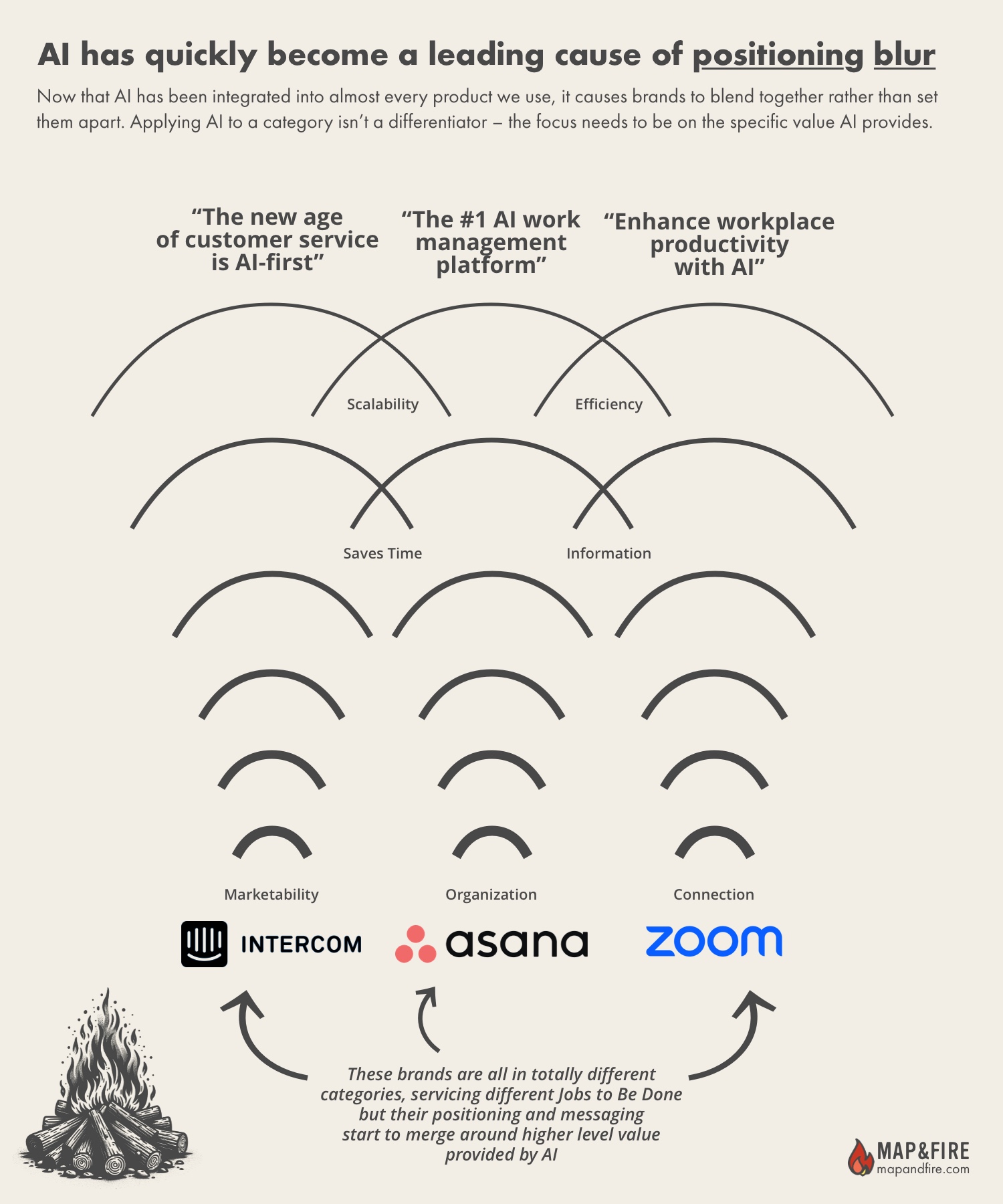
“Enhance workplace productivity with AI”
“The #1 AI work management platform”
“The new age of customer service is AI-first”
If you saw those headlines on their own it would be tricky to figure out what kind of product they’re marketing…and it would be next to impossible to guess the actual brand behind each of them.
The problem this highlights is positioning blur.
It happens when brands do one of two things:
- They adopt value propositions that overlap significantly with competitors
- They use high level benefits or capabilities that obscure their unique value
In the B2B world we see this pop up when brands lean too hard into big picture outcomes for their customers – e.g. “more growth!”, “increased revenue!”
(See, Hubspot’s headline: “Grow better with Hubspot”)
On the plus side, these are important benefits for almost every B2B customer.
On the negative side, these are benefits almost every B2B brand aims to deliver..
In other words, yes your B2B customers want these things, but if every brand aims to deliver them they lose any impact specific to your brand.
There’s no way that someone would consume positioning and messaging around “more growth” or “increased revenue” and be able to connect it to any particular brand.
Should brands deliver these things? Yes!
Should they focus their core positioning around them? No!
In a very short period of time, AI has joined this same camp.
AI’s shift from standout to standard

It’s incredible how quickly AI has been integrated into virtually every part of our business lives.
In fact it’s happened so fast that by the time some brands have gone through the process to adjust their positioning to center on AI it’s almost too late for it to provide a real impact.
It’s gone from a differentiator to a checkmark.
This is why it’s joined the ranks of positioning blur culprits.
It’s important to note though that it’s not AI itself that causes brands to blur – it’s when a brand leans into AI at the expense of articulating value and differentiation.
It wasn’t long ago that AI had an almost magical quality to it. When ChatGPT launched it was the first mainstream exposure to engage with AI for a lot of people.
Excitement and demand around AI exploded. If your product or brand utilized AI it was a real differentiator.
Fast forward a year or two later and this technology is now part of our everyday existence.
You’d be hard pressed to find a successful B2B product that doesn’t include some sort of AI integration.
And it’s because it’s now ubiquitous that AI doesn’t work to create an effective position on its own.
Brands have to go deeper and get more specific.
Again, it’s not that AI isn’t part of the story. AI absolutely unlocks all kinds of new value for businesses. Brands can and should speak to this.
The point is that AI isn’t the star, it’s a facilitator.
The star needs to be the actual value that the product provides.
How to remove blur from your positioning strategy
To fix issues with positioning blur you have to go back to the foundation.
This means you need to get crystal clear about the 3 core areas of your positioning:
- Customers: Who is this for and what Jobs to Be Done does it help satisfy?
- Competition: Where does your brand provide differentiated value?
- Offering: How does it deliver on this value?
Your website’s headline and subheadline serve as a primary conduit of your positioning.
When you capture those points of positioning it means that within a few seconds of landing on a website, a visitor knows:
- This offering is relevant to my needs
- It’s different than the other solutions I’ve considered
- I have a sense of how it actually works
If we look again at Asana’s messaging as an example:
The #1 AI work management platform
With Asana, you can drive clarity and impact at scale by connecting work and workflows to company-wide goals.
We see how this falls short:
- “AI work management”, “drive clarity and impact” – this is relevant on a very high level but it’s extremely vague
- In the space of project / work management “connecting work to goals” is about as standard and undifferentiated as you can get – it’s not clear how AI contributes
- AI seems to be the implied “how” but again there are no specifics
This is why leaning into broad stroke uses of AI creates positioning blur.
This messaging relies on:
- Assumed interpretations of AI’s value
- A belief that simply mentioning AI has meaning
But in reality it obscures value and leaves question marks.
When you dig deeper into Asana’s website you can see some of the specific use cases where AI could provide real value:
- Generate summaries across projects to keep stakeholders informed
- Identify potential risks within a project a team might otherwise miss
- Create workflows that automatically connect integrated tools
What all these statements share is that they hit on the actual value the product delivers without any mention of AI.
By leaning into these tangible customer needs it provides the seeds for how their positioning and messaging can get more clear and specific.
Don’t let AI obscure your brand’s value
We’ve only scratched the surface of the value AI can provide. As the technology evolves it will continue to unlock new opportunities to elevate our work.
But we have to remember two key points:
- AI facilitates value – it’s not valuable in and of itself
- As AI continues to expand its reach it becomes more and more critical to explain how it facilitates value for each specific product and brand
When working on your brand’s positioning and messaging always come back to those 3 core areas – customers, competition, offering.
No matter how technology evolves or changes, those fundamental building blocks stay the same.
It’s critical to make sure your target audience knows the specific value you provide, how it’s different, and why it’s relevant to them.
If you obscure that with talk of AI just on its own you’re more likely to blend in than to stand out.

Get Help Positioning Your Brand
If you’re ready to build stronger connections with your customers, reach out for a free consultation. We’ll help you transform your best business thinking into an actionable, shareable, growth-oriented guide. Click below to learn more about the Brand Guidebook process.

